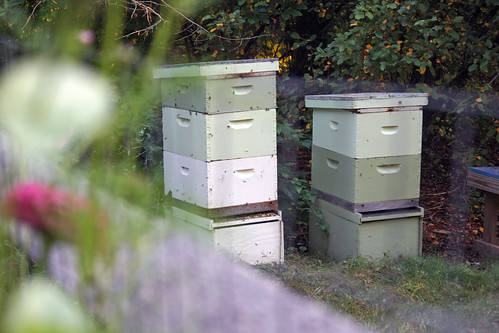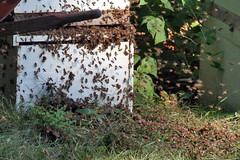
I'm in the process of preparing my honeybee hives for winter. I have two hives on the far side of my vegetable garden nearest the pond. They're on the northeast side of the yard with a southwest exposure. Both were packages I installed in early April, since both my hives died early last winter. One hive is much stronger than the other. The strong one has about 70 lbs of honey, while the weak one about 30-40 lbs. I'm guessing here from lifting the boxes.
This is what I've done and am planning to do for winter:
Done
- Removed super and extracted honey: In early September I removed one full super (a short box with 10 frames for building comb and filling it with honey) from my strong hive. I've extracted it into a bucket and will bottle in 4 lb jars soon. It'll be about 20 lbs plus or minus I think.
- Feeding weak hive: I've been feeding my weak hive so it can build up its honey stores for winter. There aren't many flowers left now, the goldenrod is gone. I only see the late aster in bloom now. The bees can't get much nectar from foraging anymore. I feed a 1:2 mix of water and sugar.
- Fed strong hive: Yesterday I put the super with wet frames (the same super I extracted, but since I only extracted about 80% of the honey, meaning 20% is still in the combs, it's called a wet frame) onto the strong hive.
Mistakes: I made the mistake of putting the exposed wet super in a wheelbarrow and leaving it
next to the hive while I started my smoker. Being exceptionally poor at starting a smoker, the box
sat exposed for a while. Somehow, I also dripped some honey on the ground in front of the hive.
When I returned to the hive with my somewhat lit smoker, a frenzy had started. Arrgh. My bees,
my neighbors bees, who knows who all came to the party. I put the wet super on the strong hive
and covered it up. Nevertheless the frenzy continued all day. - A couple of mistakes to avoid!


- Increase sunlight: I trimmed the branches of the crab apple tree that's grown out and around the hives, especially the weak one. I still need to trim more next time I'm suited up. (I wonder if the lower amount of sun over the past season may have weakened this hive.)
Planning to do
- Get bigger feeding bucket: I've been feeding the weak hive about a liter at a time, but they eat it so fast I can't keep up with them, The bucket seems always empty. They only have a short time left when they can dry down the sugar water and store it as honey. Once it gets cold, they need all their energy to stay warm. So I'm planning to add a bigger container of sugar water today. I'm using a chicken water feeder with bent hardware cloth in the tray so the bees can climb down the the liquid.
- Count mites: I'm planning to do a sugar roll to count mites in both hives. I haven't treated for mites, but I'd still like to know what the load is going in to winter.
- Full inspection of hives: I plan to go through both hives, frame by frame, and get a good count of how much honey and brood are there. I'll check for the queens, and make sure they're laying well.
- Build a box to absorb winter condensation: I'm planning to build a box (called a quilt box) that sits at the top inside the hive and insulates, helps with airflow, and absorbs moisture. I will staple burlap to the bottom of a super and fill it with wood shavings. Pretty simple design. (I have to find out if it should go above or below the top board.) I'm hoping it will help. It's my guess I lost my hives last year because of condensation dripping into the cluster of bees. Bees can stay warm in cold weather, but not if they're wet. My hive are very close to the pond and we get lots of local fog from it.
- Remove super. I'll take off the super with wet frames from strong hive once its dry and all of the honey has been brought down into the hive.
- Add mouse guard. There a millions of mice in our woods, looking for a winter shelter. They can easily climb in through the lower entrance if it's left open like it is all summer. I bought a couple fancy mouse guards from Maxant. It looks like the holes will be better for the bees than hardware cloth I've used in the past. Its a nice sturdy product. The quilt box and mouse guard will go on at the end of October. (I'll check for any mice already inside the hive before putting on the guard!)
After this, they should be ready to go for winter. At least as ready as I can get them. Of course, I can always use advice. I've been keeping bees 3 years now, and have plenty more to learn. I learned from my class, from experts at my local bee club, from advice on this blog, and from my bees (trial and error). But still I almost never spot a queen, I'm very bad a string a smoker and keeping it going, haven't had the time to do mite treatments or sugar rolls yet. And I've only had 1 of 4 hives survive a winter. But I have produced over 150 lbs of honey so far. Really delicious honey. And me and the bees have fun hanging out in the garden.
No comments:
Post a Comment